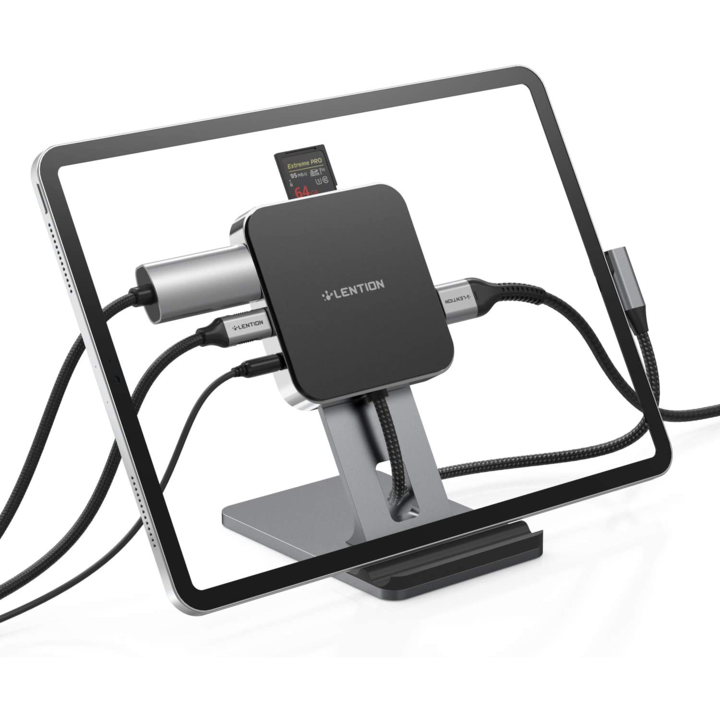What is a Docking Station for your PC / Laptop?
Many people own laptops or portable computers. Occasional situations can arise when a laptop requires the extra functionality offered by a desktop computer, however, USB C Multiport Hub help fill the gap.
The docking station acts as a base station for a portable computer and provides a way to "power on" or connect electronic devices.
Docking stations are often used to connect laptops to peripheral devices such as scanners, mice, keyboards, monitors, and external hard drives. A docking station can be especially useful if a laptop has a small number of USB ports or sockets that allow connections to other electrical devices.
What is Dock Station for?
Unlike a conventional computer, the notebook has fewer resources to optimize your system and connectivity. With fewer USB ports, the possibilities for inserting network cables, pen drives, and other accessories are reduced.
The iPad pro docking station comes as a solution for expanding notebook ports. Thus, you will be able to increase the productivity of your device according to your need.
In addition, you will be able to organize your work environment in a way that you do not need to connect the devices every time you use them since everything is switched on to the Dock Station. In other words, you just need to connect the Dock Station to your notebook and you'll still have the mobility you need to carry out your daily tasks anywhere.

There are three types of Dock Station: Dock Station port replicator, Converter Dock, and Computer Stand.
The “port replicator” Dock Station is simpler and has the additional interfaces and ports compatible with MacBooks and other most used Dell models. Its design is compact and it does not alter the notebook's basic and original functions.
The Converter Dock Station, on the other hand, creates an interface that did not originally come from the notebook factory, such as a memory reader or a port for Ethernet connectivity. The Converter Dock is much more precise than the other options and acts directly on the system, creating options for the addition of new hardware and video card, however, are not portable.
Finally, the Computer Stand, which is focused on structure and ergonomics, providing a base for installation. And that is even helping to cool the system through fans, preventing components such as processors from being damaged by lack of heat dissipation.
What it contains?
A docking station or port replicator is a device or accessory used to turn a laptop into a desktop computer. This device is intended to remain on the desktop along with the rest of the peripherals that normally accompany a desktop CPU. It offers all the connectivity and functions of a desktop computer and allows the permanent connection of certain peripherals and devices such as screen, mouse, keyboard, power cable, etc.
docking station contains bundled cable lines designed to duplicate those used for common peripheral devices. The laptop is connected to a plug and socket in the docking port, through which it is connected to all peripherals connected through the port. Depending on the system, a portable computer can be turned on “hot”. That is, connected and disconnected to the docking station while running "cold", i.e. only when turned off, or in "standby", i.e. the laptop can be docked/undocked while running, but only in sleep mode.
Advantages of using a docking station:
Today, users increasingly demand to be able to work with the comfort of a desktop environment (larger screen, keyboard, and more ergonomic mice than those provided by laptops). Also, the mobility that a laptop offers them, increasing the number of teachers who choose this option.
For this reason, the Computing Service has decided to include a docking station next to each laptop in this edition of the Remove, hoping to obtain the following benefits:
- Simplify users' work environment by saving you the hassles described above
- Reduce spending on IT equipment in departments, since each user who uses this work mode can free up a CPU (keeping their monitor, keyboard, and mouse to connect it to the docking station) that can be reassigned to another companion as long as it is within the minimum maintenance threshold.
- It allows meeting the needs of a desktop and laptop computer with a single device.
- Reduce incidents and problems for users in the operation of their equipment, who will be able to work and become familiar with a single piece of equipment instead of using several alternatively and sporadically.
- With this, reduce the maintenance costs of the University's microcomputer park.
Now that you know what a Dock Station is for and it’s several benefits, it's time to choose yours! Visit our website lention.com and explore through a wide range of docking stations. Also, buy a MacBook Air screen protector for extra security of your PC.


Leave a comment